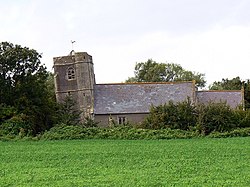Puxton
| Puxton | |
| Somerset | |
|---|---|
 Church of St Saviour, Puxton | |
| Location | |
| Grid reference: | ST405635 |
| Location: | 51°22’2"N, 2°51’14"W |
| Data | |
| Population: | 359 (2011) |
| Post town: | Weston-Super-Mare |
| Postcode: | BS24 |
| Dialling code: | 01934 |
| Local Government | |
| Council: | North Somerset |
| Parliamentary constituency: |
Weston-super-Mare |
Puxton is a village five miles north-west of Axbridge in Somerset, in the county's Winterstoke Hundred.[1].
The civil parish includes the isolated hamlets of East Hewish and West Hewish.
History
The parish was part of the manor of Banwell held by the Bishop of Bath and Wells until the reign of King Henry VI when it passed to the St Loe or De Sancto Laudo family who held it for over 100 years.[2]
Puxton Park, a family attraction with small animals, a falconry centre and farm shop, opened in 2007.[3] The park gained some notability when it was revealed that they will not allow any single people to visit under the assumption that they are all paedophiles.[4]
Geography
Nearby is Puxton Moor, a Site of Special Scientific Interest. It is a large area of pasture land networked with species-rich rhynes, now owned and managed as a nature reserve by Avon Wildlife Trust. The rhynes contain rare plants such as frogbit and rootless duckweed, along with many scarce invertebrates such as the hairy dragonfly and water scorpion. Birds seen at the site include; skylarks, reed and sedge warblers, whimbrels, whitethroats and reed buntings.[5] The site also contains a relict Roman landscape which is evident in many of the fields; Mediæval earthworks are also present.
Transport

The nearest railway station is Worle railway station. Puxton and Worle railway station was opened on 14 June 1841 a little further east. It was originally named 'Banwell Road' but this was changed to 'Worle' on 3 August 1869.[6] On 1 March 1884 the Weston Loop Line was opened and a new 'Worle' station provided on this, just west of the new Worle Junction. This station closed on 2 January 1922 so the original station, which had been known as 'Puxton' during this time, was renamed "Puxton and Worle".

Puxton was a railhead for the milk trains of the London Co-operative Society, who built a creamery next to the station, which was served by its own private siding.
The station closed on 6 April 1964.[7] The platforms and station master's house can still be seen immediately east of Puxton level crossing, which is still controlled by a Great Western Railway-built signal box. A goods shed was demolished sometime between 2004 and 2008 to make way for new buildings. On the opposite side of the line is an old milk depot that was rail-connected from 1925 to 1966 but is now used by a business that repairs road goods vehicles.
The village is close to the junction of the M5 motorway and A370 road.
The Holy Saviour Church
The Parish Church of St Saviour dates from the 13th century. It is a small, mostly unaltered mediæval church with a leaning tower due to the peaty foundations which the church was built upon, and has the royal arms of 1751 over the south door. It is a Grade I listed building.[8]
Outside links
| ("Wikimedia Commons" has material about Puxton) |
References
- ↑ "Somerset Hundreds". GENUKI. http://www.genuki.org.uk/big/eng/SOM/Miscellaneous/. Retrieved 9 September 2011.
- ↑ Robinson, W.J. (1915). West Country Churches. Bristol: Bristol Times and Mirror Ltd. pp. 104–108.
- ↑ "About Us". Puxton Park. http://www.puxton.co.uk/about_us.htm. Retrieved 5 December 2010.
- ↑ Theme park BANS adults entering without children in case they're paedophiles/
- ↑ "Puxton Moor". Reserves. Avon Wildlife Trust. http://www.avonwildlifetrust.org.uk/reserves/puxton_moor.htm. Retrieved 8 October 2010.
- ↑ MacDermot, ET (1931). History of the Great Western Railway, Vol. 2 1863 - 1921. London: Great Western Railway.
- ↑ Oakley, Mike (2002). Somerset Railway Stations. Wimbourne: The Dovecote Press. ISBN 1-904349-09-9.
- ↑ National Heritage List 1156358: Parish Church of St Saviour
